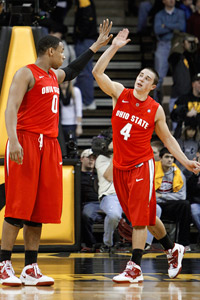
With the 2010-11 college basketball season now a couple months behind us, and the long days of summer ahead, basketball fans may be in need of the occasional pick-me-up to tide them over to next season, or at least to help ease them through the withdrawal process before they have the opportunity to have a full-blown relapse next fall. Certainly news like that of Da Dukies being on the 2011-2012 schedule provides a welcome rush, and we hope for more of those tasty nuggets of “legitimate” basketball news to chew on in the coming days, but today we’ll just settle in for talking some hoops in general.
The topic for today is the first of what will be a few “debate” articles here on tBBC. Any sports fan worth their salt loves to engage in a bit of friendly back-and-forth when it comes to their preferred competitive athletic pursuit, whether it be about the finer points of the triangle offense or just the top 3 reasons that M*chigan sucks so bad. Debate gets people engaged, it gets a dialogue going, and it gives an opportunity for any old individual to act the expert on a given subject. Debate is what makes our country so great! You have your opinion, I have mine, so let’s hash it out! And if we’re lucky, in the process we’ll be able to effectively prevent any legislation from being passed!

The first item on the docket is the classic question of whether basketball is a “big man’s game” or a “little man’s game.” This debate used to be even more of an issue when guards, forwards, and centers were more clearly defined. In the not-too-distant past, guards ran the show on the perimeter and big men roamed the paint on the interior. Guards were outside shooters and big men scored their points close to the basket. Guards racked up steals, big men accrued blocks. Simple and straightforward. But who “owned” the game?
Most comments I have heard give the nod to the guards, or the “little” guys. The idea is that the guards have the ball in their hands the majority of the time, they score most of the points, and they can make or break your team with their ability (or inability) to set up the offense and effectively control tempo. When kids are growing up they spend a lot of time dribbling and shooting from outside – classic guard functions. Therefore, basketball always has been and always will be a little man’s game.

However, who can argue with the pure dominance of an elite big man on the floor? When you’re talking about “unstoppable,” you’re more likely to reference a player like Shaquille O’Neal (in his day), or Hakeem Olajuwon, or Patrick Ewing (especially while donning his Hoyas jersey at Georgetown). When you see a tall kid at school, there’s a reason you wonder if they play basketball, and it’s because of the advantage these guys can exercise over opponents on the court. Big men may get a bad rap as being less skilled than guards, relying on height and strength rather than true basketball talent, honed over time. But that’s kind of like saying that an Olympic sprinter should get less credit for relying on natural speed. Basketball is a game for big athletes, so clearly it’s a big man’s game!
As alluded to earlier, this debate has been muddied by the emergence of hybrid players over the past 10-15 years. These days you have guys as tall as seven feet handling the ball and launching three’s from downtown. The trend doesn’t really go the other way, with 6′ players leading the team in rebounds and blocks, but overall you could say that things have evened out if you were to graph the height from “little man” to “big man” on a typical team. This past season Ohio State provided a pretty good example with their starting five. You had three guards each in the 6’5 or 6’6 range, and out of the three of those, the shortest (David Lighty) made the most natural transition to play under the hoop due to his strength.
At the same time, Ohio State’s squad from the season just past also provided some of the more classic examples for this debate. Aaron Craft was a true point guard, focused on defense, running the offense, and distributing the ball, while Jared Sullinger was the epitome of the dominant big man, shoving people around down low, grabbing rebounds and scoring in bunches. Was the Buckeyes’ style one that suggested it was a big man’s game, or was it still guard-heavy?
Kemba Walker, from this year’s championship UConn Huskies team, might have something to say about whether basketball is a guard’s game or a big man’s game. However, you can’t forget (although you may want to) that only two years prior it was big man Tyler Hansbrough taking home POY honors and the national championship trophy. In the end you probably have to simply look at who is the best individual player. When choosing teams for a pickup game, the biggest guy available may be attractive, but you’re clearly going to pick the little guy if you think he can win the game for you, right?
Must I pick a side? Well, I guess that’s the idea in a debate. All I can say is that the prospect of watching opposing teams try to handle Jared Sullinger (in his second year) and Amir Williams at the same time next year has me pretty excited. Because basketball is a big man’s game.
Add The Sports Daily to your Google News Feed!